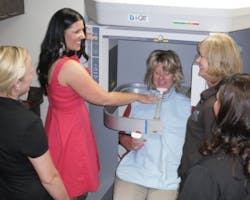Justin Moody, DDS
For more on this topic, go to www.dentaleconomics.com and search using the following key words: dental technology, 3-D imaging, CBCT, implants, modality, Justin Moody, DDS.
Investing in the right technology has many advantages for the dental office, but knowing how to efficiently use these tools is key to building momentum in the practice. When I realized that implantology was going to become an integral (and one of the most requested) part of my patients’ dental care, I explored technologies that would make this procedure more successful and less stressful. To attain this goal, I realized that I not only had to choose the right equipment, but my staff and I also had to receive the proper training to make us confident enough to use it easily, efficiently, and safely.
My CBCT scanner provides information that is integral to my implant practice, and also to patients with many other dental issues. Because of this, I needed a CBCT scanner that was flexible and a company that provided training so my whole team would understand the many capabilities with safe implementation.
Training took a day and a half, and everyone — including the front desk staff — learned how to take CBCT scans. We learned how to position the patient to obtain a quick and accurate scan. Even better, we learned about collimation — the ability to regulate the height of the beam to reduce radiation — and we were happy to know that we had this capability to focus only on our area of interest in certain cases. Empowering my staff with this knowledge allows our patients to be diagnosed and treated more quickly, which helps the office stay on schedule, and gets emergency patients out of pain and back to normal faster.
With all of the information I have learned from my training and working with the CBCT, I am now proud to offer CE classes of my own, to educate my colleagues and referring doctors about my use of CBCT and implants (BioHorizons®).
It is important to me that my course attendees understand the specific language regarding 3-D and its many functions, the many reasons why 3-D radiography is needed for procedures such as implants, and the safety precautions to be taken for the patient and the office staff. Dentists want to be sure of their diagnosis and confident of their outcomes, and patients appreciate the fact that I can avoid unnecessary surgery just to see the same dental anatomy that I can see on a CBCT without using my scalpel.
Dentistry continues to evolve as more technology than ever before becomes available to improve patient care. I always want to learn more. Besides the technical training I received as part of my investment in an i-CAT, I appreciate the company’s dedication to education. It offers so many opportunities to hear about clinical implications, from local seminars, webinars, and online courses to live events, such as the annual International Congress on 3-D Dental Imaging. This education from many sources allows clinicians to interact with leaders in the field, and offers us the greatest chance for efficiency in full implementation and clinical use of this amazing radiographic modality.
Technology is a logical choice for office investments, but dentists need more than an educated guess ... we need education, facts, and experienced trainers and dentist-instructors to help us bring imaging to its fullest potential.
Dr. Justin Moody is a diplomate with the American Board of Oral Implantology/Implant Dentistry and the International Congress of Oral Implantologists, and an associate fellow with the American Academy of Implant Dentistry. He also holds mastership and fellow status at the Misch International Implant Institute. He can be reached at [email protected].







